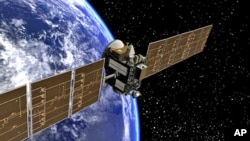A large NASA spacecraft named Dawn is barreling toward an orbital rendezvous next month with a huge space rock, and scientists are hoping the unprecedented encounter in the asteroid belt will shed new light on the history of the solar system.
Vesta is not just any asteroid. At a whopping 530 kilometers in diameter, Vesta is the second most massive object in the asteroid belt, a vast region between the planets Mars and Jupiter that's filled with rocky debris of all sizes. Vesta is officially described as a "protoplanet" because it almost formed into a planet itself, like Mars or Earth.
And, next month, Vesta is getting a visitor - the Dawn spacecraft.
Robert Mase is the Dawn project manager at NASA's Jet Propulsion Laboratory in California.
"After traveling for nearly four years, 1.7 billion miles [2.7 billion kilometers] and two laps around the Sun," said Mase, "Dawn is finally on our final approach to Vesta."
NASA's Dawn spacecraft is expected to fall into orbit around Vesta on July 16th.
For navigation purposes, the spacecraft has sent back pictures of Vesta, and the images are far sharper than the ones from the earth-orbiting Hubble Space Telescope. Researchers are already expressing surprise at the asteroid's extremely varied surface features, and the real science-gathering is not even expected to begin until August.
But how does a spacecraft get all the way from the Earth to the asteroid belt? Dawn relies partially on solar energy. The spacecraft has two solar panels, totaling about 16 meters in length. Tip-to-tip, Dawn's wingspan is about 20 meters, which Mase says makes Dawn the largest interplanetary spacecraft NASA has ever launched. Plus, Dawn has three ion engines. That is a type of propulsion that might be familiar to science fiction fans, as an alien spacecraft used it in the 1960s American television series, Star Trek.
In that episode, Captain Kirk asked Mr. Spock to identify an alien spaceship that was approaching the starship Enterprise. Spock responded, "Configuration unidentified. Ion propulsion. High velocity, though of a unique technology."
Ion engines are unique - and efficient - because they are powered by electrical fields, not chemical reactions.
NASA's Mase says ion engines initially produce very low thrust, about equal to the weight of a single piece of paper in your hand.
"So this means we go from zero to 60 [miles per hour, the equivalent of 95 kilometers per hour] in about four days," he explained. "But the ion engine can continue to thrust and accelerate, day after day, month after month, eventually achieving tremendous velocities over time."
And Dawn has time.
The spacecraft will spend a year orbiting Vesta - the first prolonged visit to a main belt asteroid. It will map the mineral composition and features of Vesta's surface, collect information about Vesta's gravity field, and peer into a massive crater that likely exposes the asteroid's interior.
Then Dawn will fire its engines again and climb away toward the dwarf planet Ceres, the largest object in the asteroid belt. It is expected to get there and drop into orbit in early 2015, and spend several months gathering data.
Mase says the Dawn mission is unusual because it is going to rendezvous with not one, but two, bodies in the solar system.
Researchers say the Vesta asteroid is no stranger to Earth. Chunks of the protoplanet have been knocked off during collisions with other space rocks, and scientists believe many of the meteorites that are found on Earth - perhaps one of out 20 - originated on Vesta.
'Dawn' Spacecraft Speeds Toward Asteroid Rendezvous










